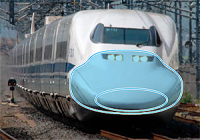Yamashita Kogyosho Co., Ltd. – Sheet Metal Processing
- Company Name: Yamashita Kogyosho Co., Ltd.
- State/Prefecture: Yamaguchi
- City/Town/Village: Kudamatsu
- Street: 1-27 Higashikaigandori
- Country: Japan
- Zip/Postal Code: 744-0002
- Website: http://www.yamashita-kogyosho.com
- Listed: 05/02/2013 4:15 pm
- Expires: This ad has expired
Yamashita Kogyosho is responsible for manufacturing the nose sections of Japan’s Shinkansen bullet trains (the “faces” of the trains). These streamlined noses are produced by craftsmen hammering aluminum sheets using a technique called “Uchidashi Bankin.” With this time-honored technique they create delicately curved surfaces by hammering carefully selected areas of the sheets very precisely by hand, carefully controlling the strength of each blow. Since replacing this highly sophisticated production process by machine would require immense amounts of time, effort and money, the company entrusts it to craftsmen.
Story: The Face of the Bullet Train – Highlighting JAPAN
The shinkansen, or “bullet train” as it is known overseas, is the super express train that made Japan’s railway technology known to the world when it debuted in 1964. One of its most distinctive features is the elongated “forehead” at the front of all the main models, many of which were produced by artisans working for the same company.
Yamashita Kogyosho Co., Ltd. is a small urban factory in Kudamatsu City, an industrial city in Yamaguchi Prefecture. The company has worked on the body structure of the front of most major models of the shinkansen from the 0 Series to the 700 Series. It has also worked on express trains as well as monorails and experimental cars for MAGLEV trains, and receives orders for train cars from places as far afield as China, Taiwan, Dubai, Singapore and South Korea.
There are very few companies in the world with sheet metal beating skills that can equal the capabilities of Yamashita Kogyosho. Aluminium sheets just a few millimeters thick are hammered into shape over an anvil. The completed parts are then welded together to produce the elegant, streamlined shape of the leading car.
“You can tell by the sound of the hammer on the metal if there is any distortion in the shape” says Jiro Kunimura, a sheet metal worker who is also one of the companys founding members. “There is far more to the job than meets the eye, and I reckon it takes a good ten years before you are anywhere near mastering it.”
In recent years, the industry has seen a shift to using cutting machinery for the process of shaving away parts of a metal body, but the manual skills of the company’s workers come into their own for very fine linings on interior parts or for complex shapes.
The president of the company himseif, Kiyoto Yamashita, was himself originally an outstanding automobile sheet metal worker. Hitachi, Ltd., one of the companies contracted to make the shinkansen cars, appreciated his ability and established Yamashita Kogyosho in 1963 to manufacture the shinkansen. “It feels like I have always lived with the shinkansen” Yamashita says.








Amazing Magnesium Violin and Aluminum Cello! They are made with the same technique employed to make nose sections for Shinkansen bullet trains
Source: Web Japan
Yamashita Kogyosho is responsible for manufacturing the nose sections of Japan’s Shinkansen bullet trains (the “faces” of the trains). These streamlined noses are produced by craftsmen hammering aluminum sheets using a technique called “Uchidashi Bankin.” With this time-honored technique they create delicately curved surfaces by hammering carefully selected areas of the sheets very precisely by hand, carefully controlling the strength of each blow. Since replacing this highly sophisticated production process by machine would require immense amounts of time, effort and money, the company entrusts it to craftsmen.
When making violins the craftsmen reproduce the gentle bulges and intricate curved surfaces of the instruments’ bodies by hammering magnesium alloy sheets. It takes approximately three months for them to complete one violin.
Continue reading »
A hammer — yes, that low-tech tool — helps mold noses of Japan’s bullet trains
By Blaine Harden: Washington Post Foreign Service
KUDAMATSU, JAPAN — No objects in Japan embody sleek design and cutting-edge technology like the noses of bullet trains. Decades of computer-aided engineering have gone into those curvaceous snouts.
It is a shock, then, to learn that they are banged out — one piece at a time — with a hammer you can buy at the Home Depot.
The banging happens here in Kudamatsu, a small factory town at the southern end of Japan’s main island. Eight craftsmen use hammers to bend and twist thin sheets of aluminum, which are then welded together to create the graceful swoops of metal that cover the front of a bullet train.
With diligence and good muscle memory, it takes a young man about 10 years to really know what he is doing with a hammer, to be able to intuitively sense from the sound and feel of a hammer’s blow how each aluminum sheet is taking shape.
Continue reading »